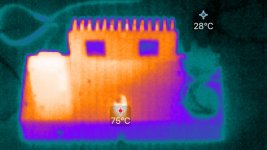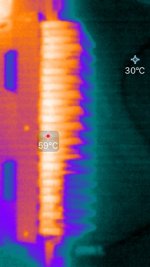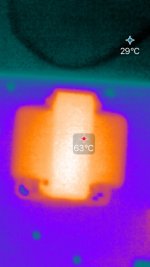Pristine clean OTL triode sound from a hybrid amp... Listening, enjoying... Sounds like I can listen the whole day & night...
I need to connect VU-meters, but can't stop listening.
Tuned to 7W/ Ch. The hottest part on the chassis is a tube. Both channels are biased equally, just the left side is being heated by the power transformer. 6 Hz - 24 KHz on -3 dB, full power from 13 Hz, below 13 Hz starts saturating.
29 degrees C overheating of the heatsink. The amp can definitely output more than 7W per channel, but with different output impedance matching transformers.
I need to connect VU-meters, but can't stop listening.
Tuned to 7W/ Ch. The hottest part on the chassis is a tube. Both channels are biased equally, just the left side is being heated by the power transformer. 6 Hz - 24 KHz on -3 dB, full power from 13 Hz, below 13 Hz starts saturating.
29 degrees C overheating of the heatsink. The amp can definitely output more than 7W per channel, but with different output impedance matching transformers.
Attachments
"""" Pristine clean OTL triode sound from a hybrid amp..."""""
Good ! , but only the true triode OTL sounds as a triode OTL and nothing else ... 😀😀 .
Good ! , but only the true triode OTL sounds as a triode OTL and nothing else ... 😀😀 .
"""" Pristine clean OTL triode sound from a hybrid amp..."""""
Good ! , but only the true triode OTL sounds as a triode OTL and nothing else ... 😀😀 .
So, it sounds even better than a triode OTL amp. 😀
Actually, it does not sound, when works below clipping. ;-)
It is a 2-stage directly coupled amp. Much simpler than My Tower amp with augmented source follower, but sounds not worse, saving some electricity!
Last edited:
One more project, waiting for output transformers...
Budget push-pull triode amplifier, 6С19П output, 6Ф12П driver & phase splitter.
I'd love to build an otl with the same tubes (4 per channel, maybe), but cannot find any good scheme.
Any suggestion? Thank you!
I'd love to build an otl with the same tubes (4 per channel, maybe), but cannot find any good scheme.
Any suggestion? Thank you!
An externally hosted image should be here but it was not working when we last tested it.
An externally hosted image should be here but it was not working when we last tested it.
These OTL's are designed to work into a 500 ohm-ish load 🙁
You would replace the original output tubes with 6C19?
Last edited by a moderator:
These OTL's are designed to work into a 500 ohm-ish load 🙁
The question was about 6С19П with 300 Ohm Ri
Output impedance matching transformer is the answer for such OTL amps.
Output impedance matching transformer is the answer for such OTL amps.
So then it is not an OTL amplifier anymore 😱
So then it is not an OTL amplifier anymore 😱
It is, actually. Driving a speaker with an impedance matching transformer inside. ;-)
The difference is in the ratio and absence of DC. The major problem in output transformers is to make them wideband, you know that. Impedance matching transformers with low ratio can be designed easier, of much better quality per price. For example, I use currently 1:5 transformers in my hybrid amp, to match 200 Ohm to 8 Ohm. Does it bear weak points of typical vacuum tube OTs, especially made for amps without NFB? Not at all!
It is, actually. Driving a speaker with an impedance matching transformer inside. ;-)
The difference is in the ratio and absence of DC.
Agree with lower ratio transformers having better bandwidth.
Do you keep DC away by an output coupling capacitor, so make a parafeed output stage actually?
In that case you would not need a transformer but an auto-transformer would do.
Agree with lower ratio transformers having better bandwidth.
Do you keep DC away by an output coupling capacitor, so make a parafeed output stage actually?
In that case you would not need a transformer but an auto-transformer would do.
Exactly! Even better. ;-)
So when the (auto) transformer is out of sight (inside the loudspeaker) we may call the amplifier OTL? 😀
Shall we agree that any inductive component (not crossover coils) between output tube(s) and loudspeaker will make the amplifier non-OTL or shorter just OT?
Shall we agree that any inductive component (not crossover coils) between output tube(s) and loudspeaker will make the amplifier non-OTL or shorter just OT?
The question was about 6С19П with 300 Ohm Ri
Output impedance matching transformer is the answer for such OTL amps.
Well, the question was about an OTL with 4 tubes per channel (like the Transcendent one) to drive an 8 ohm load.
But thank you anyway!
Agree with lower ratio transformers having better bandwidth.
Do you keep DC away by an output coupling capacitor, so make a parafeed output stage actually?
In that case you would not need a transformer but an auto-transformer would do.
That would take some biggish coupling cap
That depends.
A real OTL amplifier loaded by an 8 ohm loudspeaker impedance would require an output coupling capacitor of at least 3000 uF.
In case of a parafeed output the value of the coupling capacitor depends on the reflected loudspeaker impedance; so with a 10 : 1 step down output transformer and 8 ohm loudspeaker the amplifier would see an 800 ohm load. Then a 33 uF coupling capacitor would do with the advantage of being a quality film type instead of electrolytic.
You could even make a particular second order high pass with this amplifier when it should drive a midrange speaker and lower the value of the output cap.
A real OTL amplifier loaded by an 8 ohm loudspeaker impedance would require an output coupling capacitor of at least 3000 uF.
In case of a parafeed output the value of the coupling capacitor depends on the reflected loudspeaker impedance; so with a 10 : 1 step down output transformer and 8 ohm loudspeaker the amplifier would see an 800 ohm load. Then a 33 uF coupling capacitor would do with the advantage of being a quality film type instead of electrolytic.
You could even make a particular second order high pass with this amplifier when it should drive a midrange speaker and lower the value of the output cap.
Last edited by a moderator:
A real OTL amplifier loaded by an 8 ohm loudspeaker impedance would require an output coupling capacitor of at least 3000 uF
Not necessary. Nikola just reminded me about Cyrclotron. It has no coupling cap. However, currents go through caps in PS, but you can't use them for output HPF. ;-)
So when the (auto) transformer is out of sight (inside the loudspeaker) we may call the amplifier OTL? 😀
Shall we agree that any inductive component (not crossover coils) between output tube(s) and loudspeaker will make the amplifier non-OTL or shorter just OT?
Do you mean dynamic speaker driver as well? 😛
Is not it an inductive component?
OTL was invented to distinguish amplifiers with non-transformer DC load of an output active component from previously used transformers to load tubes. So tubes in counter-phase loaded on each other or one tube loaded on a CCS would be an OTL.
Not necessary. Nikola just reminded me about Cyrclotron. It has no coupling cap. However, currents go through caps in PS, but you can't use them for output HPF. ;-)
Let me be more specific (though you perfectly understand what I mean...):
when an output coupling capacitor is required (to block DC and this indeed depends on the output stage configuration) then the 3000 uF would be needed to ensure LF bandwidth.
Do you mean dynamic speaker driver as well? 😛
Is not it an inductive component?
OTL was invented to distinguish amplifiers with non-transformer DC load of an output active component from previously used transformers to load tubes. So tubes in counter-phase loaded on each other or one tube loaded on a CCS would be an OTL.
You perfectly understand what I mean; just a bit difficult for you to admit but that's how I know you 😉
- Status
- Not open for further replies.
- Home
- Amplifiers
- Tubes / Valves
- OTL, not OTL, & Matching VS Loading transformers


